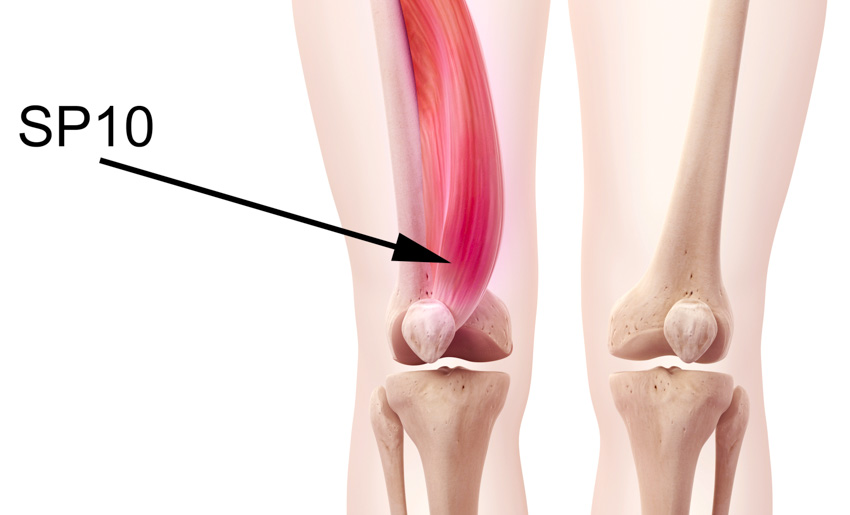
Acupuncture plus drug therapy outperforms drug monotherapy for the treatment of nodular goiter. In research conducted at the Hubei Provincial Hospital of Traditional Chinese Medicine, acupuncture plus levothyroxine produced a 91.4% total effective rate; using only levothyroxine produced a 68.6% total effective rate. The addition of acupuncture to the drug treatment protocol increased the total effective rate by 22.8%. [1]
The results were quantified with the maximum nodule diameter, number of nodules, intranodal arterial blood flow parameters, thyroid function indices, and serum levels of TGF-α and IFN-γ before and after all medical treatments. First, the maximum nodule diameter, number of nodules and intranodal arterial blood flow parameters (peak systolic velocity and resistance index) were measured with color Doppler ultrasonography. Second, thyroid function indices, including thyroid stimulating hormone (TSH), thyroxine (T4) and triiodothyronine (T3), were collected through blood sampling. Third, serum levels of TGF-α and IFN-γ were recorded. Researchers find that high expression levels of TGF-α stimulate the formation and growth of thyroid disorders, while elevated serum IFN-γ levels induce apoptosis of follicular cells and reduce the size and number of nodules. [2] [3]
After treatment, the maximum nodule diameter and number of nodules decreased in both groups. The acupuncture plus drugs treatment group produced better outcomes. The peak systolic velocity (PSV) and resistance index (RI) did not show significant changes after treatment in the drug monotherapy control group, while both parameters improved significantly in the acupuncture plus drugs treatment group. The serum level of TSH dropped significantly after treatment in the control group, while that in the treatment group did not show significant reductions after treatment.
The level of serum TGF-α declined and the level of serum IFN-γ increased in the treatment group, while there were no significant changes in the levels of TGF-α and IFN-γ in the control group after treatment. The data indicates that acupuncture plus levothyroxine is more effective in reducing thyroid nodules, regulating intranodal arterial blood flow, stabilizing thyroid function, and regulating levels of serum TGF-α and IFN-γ for the treatment of nodular goiter.
Researchers (Xiao et al.) used the following study design. A total of 70 patients were treated and evaluated. They were randomly divided into an acupuncture plus drug treatment group and a drug control group, with 35 patients in each group. For the control group patients, 25 μg of levothyroxine was orally administered once per day, for a total of three consecutive months. The treatment group received acupuncture in addition to the identical drug therapy administered to the control group.
The statistical breakdown for each randomized group was as follows. The treatment group was comprised of 14 males and 21 females. The average age in the treatment group was 42 ±11 years. The average course of disease in the treatment group was 12.43 ±6.57 months. The control group was comprised of 12 males and 23 females. The average age in the control group was 42 ±8 years. The average course of disease in the control group was 12.77 ±5.15 months. There were no significant statistical differences in gender, age, and course of disease relevant to patient outcome measures for patients initially admitted to the study.
The treatment group patients received one session of acupuncture therapy, 30 minutes every two days, for a total of 3 months. The acupoints used for the treatment group included the following:
- CV22 (Tiantu)
- SP10 (Xuehai)
- ST40 (Fenglong)
- LV3 (Taichong)
For Tiantu, a 40 mm long needle was first inserted to a depth of 0.2 cun, and then the needle was pointed downward to a depth of 0.5 – 0.8 cun along the posterior face of the sternum. For Xuehai, Fenglong, and Taichong, the needle was inserted perpendicularly to a depth of 1 cun. The attenuating (xie) manipulation technique was applied. In addition, local non-acupoints were selected for treatment. First, a 25 mm long needle was inserted into the center of each nodule, reaching a depth of 0.5 cun. Then, 2 – 5 points were selected around the nodule center and inserted using the "surrounding needle" (weici) technique, to a depth of 0.5 – 0.8 cun.
The results indicate that using acupuncture in an integrated treatment protocol significantly reduces or eliminates thyroid nodules, regulate intranodal arterial blood flow, regulates thyroid function indices, and regulates serum levels of TGF-α and IFN-γ. The research team concludes that acupuncture is safe and effective for the treatment of nodular goiter.
References:
[1] Xiao Honghui, Liu Simin. (2021). Therapeutic Efficacy of Acupuncture Combined with Levothyroxine Sodium for Nodular Goiter and Its Effects on Serum TGF-α and IFN-γ. Shanghai Journal of Acupuncture and Moxibustion, 40(10):1191-1196.
[2] Poteet E, Liu D, Liang Z, et al. (2019). Mesothelin and TGF-α predict pancreatic cancer cell sensitivity to EGFR inhibitors and effective combination treatment with trametinib[J]. PLoS One,14(3): e0213294.
[3] Shin J, Kim KP, Ahn HY, et al. (2019). Alterations in IL-4, IL-10 and IFN-γ levels synergistically decrease lipid content and protein expression of FAS and mature SREBP-1 in human sebocytes. Arch Dermatol Res, 311(7):563-571.


